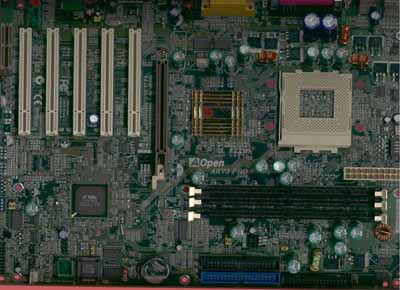Socket-A VIA KT133 Motherboard Roundup - November 2000
by Henry Kuo on November 30, 2000 5:15 AM EST- Posted in
- Motherboards
AOpen AK73 Pro
|
AOpen AK73 Pro |
|
|
CPU Interface
|
Socket-A
|
|
Chipset
|
VIA
KT133
|
|
Form Factor
|
ATX
|
|
Bus Speeds
|
100
/ 102 / 104 / 106 / 107 / 108 / 109 / 110 / 111 / 112 / 113 / 114 / 115
/ 116 / 118 / 120 MHz
|
|
Voltages Supported
|
1.10 - 1.85V in 0.025V increments
|
|
Memory Slots
|
3
168-pin DIMM Slots
|
|
Expansion Slots
|
1 AGP Slot
5 PCI Slots (5 Full Length) 1 AMR Slot |
|
On-board Audio
|
AD1885
AC97 CODEC
|
|
BIOS
|
Award
Modular BIOS 6.00PG
|
The AK73 Pro just made its way to our KT133 roundup. Compared to other KT133 solutions, it might have come a bit late, but it’s definitely worth it. First off, it has multiplier ratio settings implemented through a set of dipswitches, so users can use the AK73 Pro to overclock their AMD processors easily, again, provided that they are unlocked.
Moreover, AOpen also implemented a set of CPU core voltage settings as well as I/O voltage settings with control from within the BIOS. However, when come to FSB speeds, the AK73 Pro only supports the following: 100 / 102 / 104 / 106 / 107 / 108 / 109 / 110 / 111 / 112 / 113 / 114 / 115 / 116 / 118 / 120 MHz. The lack of the 105MHz FSB setting can possibly affect the overclocking potential of the motherboard, as shown in our overclocking tests. With 104MHz, everything was rock solid, but when we set the FSB speed to 106, which is the next FSB speed setting, the board lost its stability. We do not know if 105MHz will work, but at least if it was implemented, we could have tested it out.
Probably one of the reasons why the AK73 Pro came a bit late is that AOpen wanted to incorporate the VIA 686B Super South Bridge. As we discussed earlier, the VIA 686B South Bridge provides Ultra ATA 100 support, whereas the old VIA 686A only supports Ultra ATA 66.
In our stability tests, the AK73 Pro was rock solid, mainly the result of a solid layout, proper placement of surface mount components, as well as the choice of capacitors around the CPU socket.
Just like most AOpen motherboards, the AK73 Pro also has their trademark Die Hard BIOS. Basically AOpen outfits the board with two BIOS chips, therefore if one of the chips got corrupted either during failed BIOS updates or by a virus, users can still boot up the system with the other BIOS chip. This is very attractive to OEMs that receive a high number of RMAs from corrupted BIOS images. The feature was derived from the success of Gigabyte’s DualBIOS.
With its rock solid stability, AOpen has become yet another contender in the KT133 market. Stay tuned for our individual review on the board shortly after this roundup for more detailed information on the board.











0 Comments
View All Comments